9.3 Bivariate Distribution Visualization¶
import numpy as np
import matplotlib.pyplot as plt
from scipy.stats import multivariate_normal
def bivar(graphtype, mupos=None, sigpos=None, rhopos=None, muneg=None, signeg=None, rhoneg=None):
if mupos is None:
mupos = np.array([4, 4])
sigpos = np.array([1, 1])
rhopos = 0
muneg = np.array([2, 2])
sigmaneg = np.array([[1, -0.6], [-0.6, 1]])
else:
sigmapos = np.array([[sigpos[0], rhopos * np.sqrt(sigpos[0] * sigpos[1])],
[rhopos * np.sqrt(sigpos[0] * sigpos[1]), sigpos[1]]])
if signeg is None:
sigmaneg = np.array([[1, -0.6], [-0.6, 1]])
else:
sigmaneg = signeg
Npos = 100
Nneg = 100
pos = np.random.multivariate_normal(mupos, sigmapos, Npos)
neg = np.random.multivariate_normal(muneg, sigmaneg, Nneg)
mn = np.min(np.concatenate((pos, neg), axis=0))
mx = np.max(np.concatenate((pos, neg), axis=0))
x = np.arange(mn, mx, 0.1)
y = np.arange(mn, mx, 0.1)
X, Y = np.meshgrid(x, y)
Ppos = np.zeros_like(X)
Pneg = np.zeros_like(X)
L = np.zeros_like(X)
for i in range(len(x)):
for j in range(len(y)):
Ppos[j, i] = getprob(x[i], y[j], mupos, sigmapos)
Pneg[j, i] = getprob(x[i], y[j], muneg, sigmaneg)
L[j, i] = Pneg[j, i] / Ppos[j, i]
Pb = (1 / (2 * np.pi * np.sqrt(np.linalg.det(sigmapos)))) * np.exp(-1 / 2)
Ps = (1 / (2 * np.pi * np.sqrt(np.linalg.det(sigmaneg)))) * np.exp(-1 / 2)
plt.figure(figsize=(8, 8))
if graphtype == 2:
plt.axis('square')
plt.axis([mn, mx, mn, mx])
plt.scatter(pos[:, 0], pos[:, 1], color='r', label='Positive')
plt.scatter(neg[:, 0], neg[:, 1], color='b', label='Negative')
plt.contour(X, Y, Ppos, levels=[Pb], colors='r')
plt.contour(X, Y, Pneg, levels=[Ps], colors='b')
plt.contour(X, Y, L, levels=[1], colors='k')
plt.plot([mupos[0], muneg[0]], [mupos[1], muneg[1]], color='k', linestyle=':')
elif graphtype == 3:
from mpl_toolkits.mplot3d import Axes3D
fig = plt.figure(figsize=(8, 8))
ax = fig.add_subplot(111, projection='3d')
ax.plot_surface(X, Y, Ppos, cmap='Reds', edgecolor='none', alpha=0.6)
ax.plot_surface(X, Y, Pneg, cmap='Blues', edgecolor='none', alpha=0.6)
ax.contour3D(X, Y, Ppos, levels=[Pb], cmap='Reds')
ax.contour3D(X, Y, Pneg, levels=[Ps], cmap='Blues')
plt.show()
def getprob(x, y, mu, sigma):
vec = np.array([x, y])
E = 2 * np.pi * np.sqrt(np.linalg.det(sigma))
P = (1 / E) * np.exp(-0.5 * np.dot(np.dot((vec - mu), np.linalg.inv(sigma)), (vec - mu).T))
return P
bivar(2, mupos=[4, 3], sigpos=[1, 1], rhopos=0, muneg=[2, 2], signeg=[[1, -0.6], [-0.6, 1]], rhoneg=0)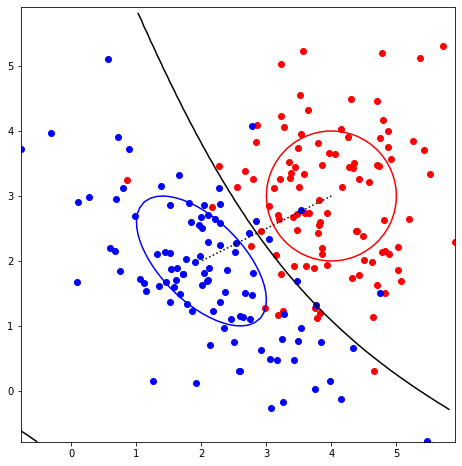
9.5 Density¶
import numpy as np
import matplotlib.pyplot as plt
from scipy.stats import norm
from scipy.stats import gaussian_kde
points = np.random.normal(size=20)
plt.hist(points, bins='auto', density=True, alpha=0.5, edgecolor='black')
plt.plot(points, np.zeros_like(points), '|', color='black', markersize=15)
x = np.linspace(min(points) - 1, max(points) + 1, 1000)
plt.plot(x, norm.pdf(x), linestyle='dotted', color='black')
mu = np.mean(points)
sigma = np.std(points, ddof=1)
plt.plot(x, norm.pdf(x, mu, sigma), color='blue')
kde = gaussian_kde(points)
plt.plot(x, kde(x), color='red')
plt.xlabel('')
plt.title('')
plt.show()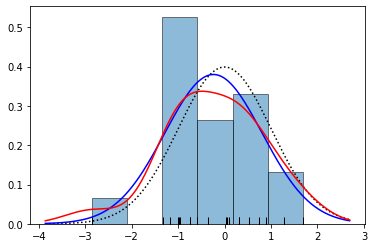
import numpy as np
import matplotlib.pyplot as plt
from scipy.stats import norm
from scipy.stats import gaussian_kde
points = np.random.uniform(-2, 2, 20)
plt.hist(points, bins='auto', density=True, alpha=0.5, edgecolor='black')
plt.plot(points, np.zeros_like(points), '|', color='black', markersize=15)
mu = np.mean(points)
sigma = np.std(points, ddof=1)
x = np.linspace(min(points) - 1, max(points) + 1, 1000)
plt.plot(x, norm.pdf(x, mu, sigma), color='blue')
kde = gaussian_kde(points)
plt.plot(x, kde(x), color='red')
plt.xlabel('')
plt.title('')
plt.show()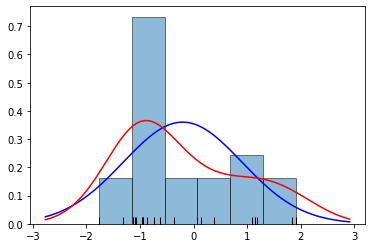
9.6 Linear Classifier 2¶
import numpy as np
import matplotlib.pyplot as plt
import statsmodels.api as sm
def linclass():
mupos = np.array([1, 1])
sigpos = np.array([0.1, 0.6])
rhopos = 0.1
mupos2 = np.array([2, -1])
sigpos2 = np.array([0.2, 0.2])
rhopos2 = 0
muneg = np.array([-1, -1])
signeg = np.array([0.6, 0.1])
rhoneg = 0.1
muneg2 = mupos2
signeg2 = sigpos2
rhoneg2 = rhopos2
covpos = rhopos * np.sqrt(sigpos[0] * sigpos[1])
sigmapos = np.array([[sigpos[0], covpos], [covpos, sigpos[1]]])
covpos2 = rhopos2 * np.sqrt(sigpos2[0] * sigpos2[1])
sigmapos2 = np.array([[sigpos2[0], covpos2], [covpos2, sigpos2[1]]])
covneg = rhoneg * np.sqrt(signeg[0] * signeg[1])
sigmaneg = np.array([[signeg[0], covneg], [covneg, signeg[1]]])
covneg2 = rhoneg2 * np.sqrt(signeg2[0] * signeg2[1])
sigmaneg2 = np.array([[signeg2[0], covneg2], [covneg2, signeg2[1]]])
Npos = 100
Npos2 = 5
Nneg = 100
Nneg2 = 5
pos = np.vstack([np.random.multivariate_normal(mupos, sigmapos, Npos - Npos2),
np.random.multivariate_normal(mupos2, sigmapos2, Npos2)])
neg = np.vstack([np.random.multivariate_normal(muneg, sigmaneg, Nneg - Nneg2),
np.random.multivariate_normal(muneg2, sigmaneg2, Nneg2)])
plt.figure(1)
plt.scatter(pos[:, 0], pos[:, 1], c='k', marker='+', label='Positive')
plt.scatter(neg[:, 0], neg[:, 1], c='k', marker='.', label='Negative')
plt.axis([-3, 3, -3, 3])
plt.gca().set_aspect('equal', adjustable='box')
plt.legend()
pos1 = np.hstack([np.ones((Npos, 1)), pos])
neg1 = np.hstack([np.ones((Nneg, 1)), neg])
x = np.vstack([pos1, neg1])
y = np.hstack([np.ones(Npos), np.zeros(Nneg)])
xx = 2.8
emupos1 = np.mean(pos1, axis=0)
emuneg1 = np.mean(neg1, axis=0)
blc = (emupos1 - emuneg1)
blc[0] = -(emupos1 + emuneg1) @ blc / 2
plt.plot(emupos1[1], emupos1[2], 'ro')
plt.plot(emuneg1[1], emuneg1[2], 'ro')
plt.plot([emupos1[1], emuneg1[1]], [emupos1[2], emuneg1[2]], 'r:', lw=2)
plt.plot([-xx, xx], [(-blc[0] + xx * blc[1]) / blc[2], (-blc[0] - xx * blc[1]) / blc[2]], 'r-', lw=2)
errblc = np.sum(pos1 @ blc < 0) + np.sum(neg1 @ blc > 0)
print(f'Error for BLC: {errblc}')
lsc = np.linalg.inv(np.vstack([pos1, neg1]).T @ np.vstack([pos1, neg1])) @ (Npos * emupos1 - Nneg * emuneg1)
plt.plot([-xx, xx], [(-lsc[0] + xx * lsc[1]) / lsc[2], (-lsc[0] - xx * lsc[1]) / lsc[2]], 'y-', lw=2)
errlsc = np.sum(pos1 @ lsc < 0) + np.sum(neg1 @ lsc > 0)
print(f'Error for LSC: {errlsc}')
x_logit = sm.add_constant(x)
log_reg = sm.Logit(y, x_logit).fit()
print(log_reg.summary())
plt.plot([-xx, xx], [(-log_reg.params[0] + xx * log_reg.params[1]) / log_reg.params[2],
(-log_reg.params[0] - xx * log_reg.params[1]) / log_reg.params[2]], 'b-', lw=2)
errblr = np.sum(pos1 @ log_reg.params < 0) + np.sum(neg1 @ log_reg.params > 0)
print(f'Error for Logistic Regression: {errblr}')
Plr = log_reg.predict(x_logit)
BSlr = np.mean((Plr - y) ** 2)
print(f'Binary Logistic Regression Error: {BSlr}')
plt.show()
linclass()Error for BLC: 5
Error for LSC: 5
Optimization terminated successfully.
Current function value: 0.080978
Iterations 10
Logit Regression Results
==============================================================================
Dep. Variable: y No. Observations: 200
Model: Logit Df Residuals: 197
Method: MLE Df Model: 2
Date: Wed, 16 Jul 2025 Pseudo R-squ.: 0.8832
Time: 11:21:04 Log-Likelihood: -16.196
converged: True LL-Null: -138.63
Covariance Type: nonrobust LLR p-value: 6.725e-54
==============================================================================
coef std err z P>|z| [0.025 0.975]
------------------------------------------------------------------------------
const 0.2297 0.741 0.310 0.756 -1.222 1.681
x1 2.4097 0.609 3.957 0.000 1.216 3.603
x2 4.3632 0.965 4.520 0.000 2.471 6.255
==============================================================================
Possibly complete quasi-separation: A fraction 0.17 of observations can be
perfectly predicted. This might indicate that there is complete
quasi-separation. In this case some parameters will not be identified.
Error for Logistic Regression: 8
Binary Logistic Regression Error: 0.024398104364832786
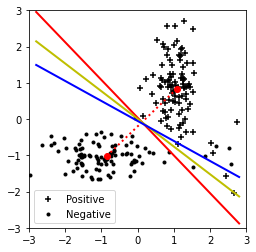
9.7 Logreg¶
import numpy as np
import matplotlib.pyplot as plt
from sklearn.linear_model import LogisticRegression
from sklearn.isotonic import IsotonicRegression
from sklearn.metrics import roc_curve, auc
mupos = 1
muneg = -1
Npos = 20
Nneg = 20
clr = Npos / Nneg
px = np.random.normal(mupos, 1, Npos)
nx = np.random.normal(muneg, 1, Nneg)
x = np.concatenate([px, nx])
py = np.ones(Npos)
ny = np.zeros(Nneg)
y = np.concatenate([py, ny])
ymin = 0
ymax = 1
y0 = (ymin + ymax) / 2
xmin = np.min(x)
xmax = np.max(x)
X = np.vstack([np.ones_like(x), x]).T
emupos1 = np.mean(np.vstack([np.ones_like(px), px]), axis=1)
emuneg1 = np.mean(np.vstack([np.ones_like(nx), nx]), axis=1)
blc = (emupos1 - emuneg1)
blc = blc[:, np.newaxis]
blc[0] = -(emupos1 + emuneg1).dot(blc) / 2
B = blc.flatten()
x0 = np.mean([np.mean(px), np.mean(nx)])
plt.figure(figsize=(8, 6))
xaxis = np.arange(xmin, xmax, 0.1)
yminB = B[0] + B[1] * xmin
ymaxB = B[0] + B[1] * xmax
plt.plot(xaxis, B[0] + B[1] * xaxis, linestyle='--', color='b')
plt.axis([xmin, xmax, ymin, ymax])
plt.axhline(y0, linestyle=':', color='k')
w = B[1]
dpos = w * (px - x0)
dneg = w * (nx - x0)
d = np.concatenate([dpos, dneg])
mdpos = np.mean(dpos)
mdneg = np.mean(dneg)
vard = np.var(np.concatenate([dpos - mdpos, dneg - mdneg]), ddof=1)
a = (mdpos - mdneg) / vard
d0 = (mdpos + mdneg) / 2
plt.axvline(x0, linestyle=':', color='b')
LR = np.exp(a * (d - d0))
P = LR / (LR + Nneg / Npos)
plt.scatter(x, P, color='b', s=20, label='Logistic Calibration')
scoresPN = B[0] + np.concatenate([px, nx]) * B[1]
sortedScores = np.sort(scoresPN)[::-1]
index = np.argsort(scoresPN)[::-1]
CHprobs = np.interp(sortedScores, np.sort(sortedScores), np.linspace(0, 1, Npos + Nneg))
PCH = CHprobs
plt.scatter(x[index], PCH, color='g', s=20, label='Isotonic Calibration')
X_reg = np.vstack([np.ones_like(x), x]).T
y_reg = y
lr = LogisticRegression(fit_intercept=False)
lr.fit(X_reg, y_reg)
PLR = lr.predict_proba(X_reg)[:, 1]
yup2 = np.min(PLR[PLR > 0.5])
xup2 = x[np.min(np.where(PLR == yup2))]
ydn2 = np.max(PLR[PLR < 0.5])
xdn2 = x[np.max(np.where(PLR == ydn2))]
x2 = xdn2 + (xup2 - xdn2) * (1 / 2 - ydn2) / (yup2 - ydn2)
plt.axvline(x2, linestyle=':', color='r')
fp2 = Npos - np.sum(y_reg[X_reg[:, 1] > x2] == 1)
fn2 = np.sum(y_reg[X_reg[:, 1] > x2] == 0)
err2 = fp2 + fn2
BS2 = np.mean((PLR - y_reg) ** 2)
plt.scatter(x, y, color='k', label='Data Points')
plt.scatter(np.mean(px), ymax, label='Mean Positive')
plt.scatter(np.mean(nx), ymin, label='Mean Negative')
plt.legend()
plt.show()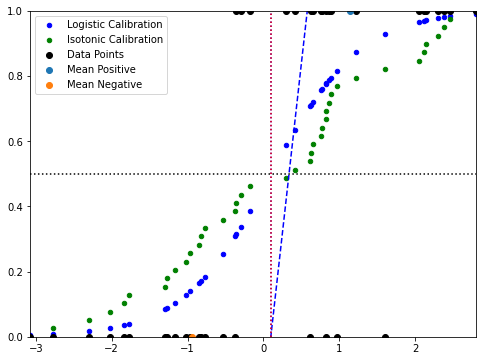
9.8 GMM¶
import numpy as np
import matplotlib.pyplot as plt
def gmm(mu1=55, sigmasq1=9, mu2=65, sigmasq2=16):
"""
Gaussian Mixture Model (GMM) using Expectation-Maximization (EM) algorithm.
Args:
mu1 (float): Mean of the first Gaussian distribution.
sigmasq1 (float): Variance of the first Gaussian distribution.
mu2 (float): Mean of the second Gaussian distribution.
sigmasq2 (float): Variance of the second Gaussian distribution.
Returns:
tuple: Final means, variances, and initial means.
"""
N1 = 5
N2 = 5
N = N1 + N2
samples1 = np.random.normal(mu1, np.sqrt(sigmasq1), N1)
samples2 = np.random.normal(mu2, np.sqrt(sigmasq2), N2)
samples = np.sort(np.concatenate([samples1, samples2]))
x = np.arange(40, 80, 0.1)
P1 = (1 / np.sqrt(2 * np.pi * sigmasq1)) * np.exp(-((x - mu1) ** 2) / (2 * sigmasq1))
P2 = (1 / np.sqrt(2 * np.pi * sigmasq2)) * np.exp(-((x - mu2) ** 2) / (2 * sigmasq2))
plt.figure()
plt.plot(samples1, np.zeros(len(samples1)), 'k.', label='Samples from Gaussian 1')
plt.plot(samples2, np.zeros(len(samples2)), 'r.', label='Samples from Gaussian 2')
plt.plot(x, P1 + P2, label='Initial sum of Gaussians')
mu0 = np.sort(np.random.randint(50, 71, 2))
mu = mu0.copy()
sigmasq = np.array([1.0, 1.0])
z = np.zeros((2, N))
iterations = 20
for k in range(iterations):
for i in range(N):
z1 = (1 / np.sqrt(2 * np.pi * sigmasq[0])) * np.exp(-((samples[i] - mu[0]) ** 2) / (2 * sigmasq[0]))
z2 = (1 / np.sqrt(2 * np.pi * sigmasq[1])) * np.exp(-((samples[i] - mu[1]) ** 2) / (2 * sigmasq[1]))
total = z1 + z2 + 1e-10
z[0, i] = z1 / total
z[1, i] = z2 / total
z1_sum = np.sum(z[0])
z2_sum = np.sum(z[1])
mu[0] = np.sum(samples * z[0]) / (z1_sum + 1e-10)
mu[1] = np.sum(samples * z[1]) / (z2_sum + 1e-10)
sigmasq[0] = np.sum(z[0] * (samples - mu[0]) ** 2) / (z1_sum + 1e-10)
sigmasq[1] = np.sum(z[1] * (samples - mu[1]) ** 2) / (z2_sum + 1e-10)
P1 = (1 / np.sqrt(2 * np.pi * sigmasq[0])) * np.exp(-((x - mu[0]) ** 2) / (2 * sigmasq[0]))
P2 = (1 / np.sqrt(2 * np.pi * sigmasq[1])) * np.exp(-((x - mu[1]) ** 2) / (2 * sigmasq[1]))
plt.plot(x, P1 + P2, color=[1, 1 - k / iterations, 0])
plt.legend()
plt.show()
return mu, sigmasq, mu0
gmm()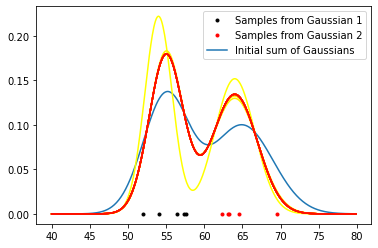
(array([55, 64]), array([4.99725208, 8.80882941]), array([50, 67]))